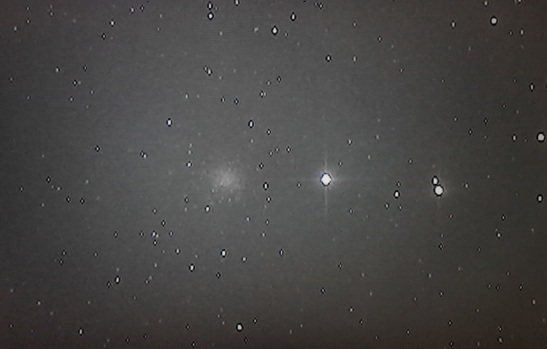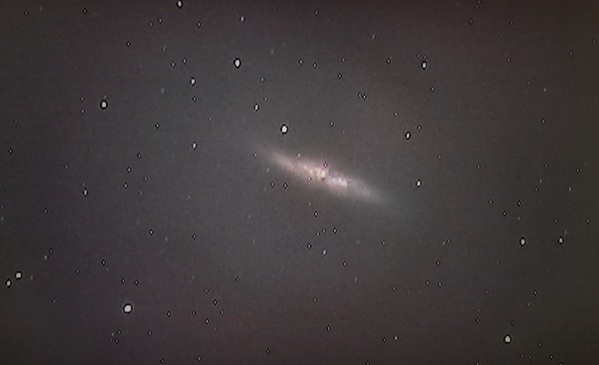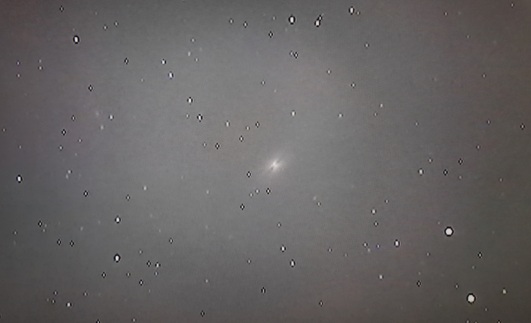- Posts: 60
- Thank you received: 5
Highlights, 23-24 November, (very) electronically assisted deep sky session.
- cathalferris
- Topic Author
- Offline
- Proto Star
-

Less
More
7 years 4 months ago #106279
by cathalferris
Highlights, 23-24 November, (very) electronically assisted deep sky session. was created by cathalferris
It's nice when it all comes together properly, for once!
I was sitting on the sofa, controlling the scope wirelessly from Cartes Du Ciel/Skychart, and watching the faint fuzzies appear on my TV screen. Staying warm, seeing detail far beyond that which I would see by eye normally with the same equipment, and just being comfortable while doing it - all made for a fantastic night in!
I'm using a Skywatcher 8" f/4 newt, on an AVX mount, auto aligned with the StarSense camera and handset, and using a SkyFi box to make wireless control happen. The camera is a lightly modified Samsung SCB2000 with the IR cutoff filter removed. All powered from a large 12v lead-acid battery, set up in the middle of the lawn out at the back of the house. The video signal I fed with a 20m cable from the scope to my television. I could control either via SkySafari Pro on the phone, or via PC running Skycharts with the ucac4 and URAT1 catalogues and using Com2TCP for the virtual com port needed for the control connection
Once I had properly polar aligned the mount and built the pointing model with the starsense - once it was dark enough for the starsense camera to register stars - I focused the camera and calibrated the camera FOV with the starsense pointing. After this was done, long before full dark, I had slews that placed the object of interest close to the centre of the screen every time when choosing with the handset, and within the centre half of the screen when using a remote program to request the slews. It was always easy enough to centre and align the planetarium program, and all slews were pretty much on point all night after that. The subzero temperatures really helped reduce the thermal noise from the camera, which was fairly noisy in the summer months.
With the 8" and the Samsung camera I was able to identify galaxies and stars down to about 16.5 to 17, with the camera "sense-up" set at 512x for effective exposures of about 10 seconds. The results were not pretty, but definitely able to locate and see things that would require a 20" and hours of painstaking work at the eyepiece to see. I don't have a 20" yet, so it's great to have that detail accessible. The chip in the camera does have a number of hot pixels which are annoying, but not too much so. They show up as a white pixel with dark borders. A future project is to do video capture on a laptop, and do live processing for noise reduction and dark subtraction, I've tried that before with limited success as I need a better capture device.
To start the evening I had a look at the Iris nebula, T Tauri nebula, and trying for the Autumn planetaries. Then it was chasing down faint galaxies around Pegasus including Stephan's Quintet, then trying to chase down the brightest quasars (BL Lacerta being the first one I identified), and having fun identifying NGC and PGC galaxies in some Abell clusters for a while.
I only took quick pics of the tv screen for some of the objects I looked at. Very dirty pics with phone from tv screen, but it's very representative of what I could see. Not bad for 10 second exposures.
NGC 2419 - the Intergalactic Wanderer in Lynx, showing some nice resolution into stars:
M82 with loads of detail and colour from the HII regions in the dust lanes:
One that I thought looked very pretty when it appeared on screen after the slew, NGC 7814 in Pegasus, even if I couldn't get the extensions to the disk:
I've definitely to do some diagonal mirror anti-dew as I had to use a pocket handwarmer heatpack on the rear of the mirror to defog after a few hours, but it stayed condensation free after that. The main mirror was starting to show condensation as well at the end of the session. That wasn't surprising really as the outside of the tube was sopping wet and beginning to freeze. Everything was damp. It probably didn't help that much that the rear of the mirror is completely exposed to the cold surroundings. Great for thermal equilibrium except when that means dew on everything!
All in all, a night of very deep viewing with relatively modest equipment, and I'm glad it all worked out and worked together.
I was sitting on the sofa, controlling the scope wirelessly from Cartes Du Ciel/Skychart, and watching the faint fuzzies appear on my TV screen. Staying warm, seeing detail far beyond that which I would see by eye normally with the same equipment, and just being comfortable while doing it - all made for a fantastic night in!
I'm using a Skywatcher 8" f/4 newt, on an AVX mount, auto aligned with the StarSense camera and handset, and using a SkyFi box to make wireless control happen. The camera is a lightly modified Samsung SCB2000 with the IR cutoff filter removed. All powered from a large 12v lead-acid battery, set up in the middle of the lawn out at the back of the house. The video signal I fed with a 20m cable from the scope to my television. I could control either via SkySafari Pro on the phone, or via PC running Skycharts with the ucac4 and URAT1 catalogues and using Com2TCP for the virtual com port needed for the control connection
Once I had properly polar aligned the mount and built the pointing model with the starsense - once it was dark enough for the starsense camera to register stars - I focused the camera and calibrated the camera FOV with the starsense pointing. After this was done, long before full dark, I had slews that placed the object of interest close to the centre of the screen every time when choosing with the handset, and within the centre half of the screen when using a remote program to request the slews. It was always easy enough to centre and align the planetarium program, and all slews were pretty much on point all night after that. The subzero temperatures really helped reduce the thermal noise from the camera, which was fairly noisy in the summer months.
With the 8" and the Samsung camera I was able to identify galaxies and stars down to about 16.5 to 17, with the camera "sense-up" set at 512x for effective exposures of about 10 seconds. The results were not pretty, but definitely able to locate and see things that would require a 20" and hours of painstaking work at the eyepiece to see. I don't have a 20" yet, so it's great to have that detail accessible. The chip in the camera does have a number of hot pixels which are annoying, but not too much so. They show up as a white pixel with dark borders. A future project is to do video capture on a laptop, and do live processing for noise reduction and dark subtraction, I've tried that before with limited success as I need a better capture device.
To start the evening I had a look at the Iris nebula, T Tauri nebula, and trying for the Autumn planetaries. Then it was chasing down faint galaxies around Pegasus including Stephan's Quintet, then trying to chase down the brightest quasars (BL Lacerta being the first one I identified), and having fun identifying NGC and PGC galaxies in some Abell clusters for a while.
I only took quick pics of the tv screen for some of the objects I looked at. Very dirty pics with phone from tv screen, but it's very representative of what I could see. Not bad for 10 second exposures.
NGC 2419 - the Intergalactic Wanderer in Lynx, showing some nice resolution into stars:
M82 with loads of detail and colour from the HII regions in the dust lanes:
One that I thought looked very pretty when it appeared on screen after the slew, NGC 7814 in Pegasus, even if I couldn't get the extensions to the disk:
I've definitely to do some diagonal mirror anti-dew as I had to use a pocket handwarmer heatpack on the rear of the mirror to defog after a few hours, but it stayed condensation free after that. The main mirror was starting to show condensation as well at the end of the session. That wasn't surprising really as the outside of the tube was sopping wet and beginning to freeze. Everything was damp. It probably didn't help that much that the rear of the mirror is completely exposed to the cold surroundings. Great for thermal equilibrium except when that means dew on everything!
All in all, a night of very deep viewing with relatively modest equipment, and I'm glad it all worked out and worked together.
The following user(s) said Thank You: michael_murphy, Kinch, Bruno, Fermidox
Please Log in or Create an account to join the conversation.
- Fermidox
- Away
- Red Giant
-

Less
More
- Posts: 644
- Thank you received: 1089
7 years 4 months ago #106280
by Fermidox
Replied by Fermidox on topic Highlights, 23-24 November, (very) electronically assisted deep sky session.
Very informative post, thanks for that. Although I don't think there's anything to compare with stars glinting in the eyepiece, the attraction of observing from a warm sofa is very tempting!
Finbarr.
Finbarr.
Please Log in or Create an account to join the conversation.
Time to create page: 0.109 seconds






